Excerpts from Jim Conrad's
Naturalist Newsletter
from the September 17, 2017 Newsletter issued from Rancho Regenesis in the woods ±4kms west of Ek Balam Ruins; elevation ~40m (~130 ft), N20.876°, W88.170°; north-central Yucatán, MÉXICO
WINGED YAM
Last April the rancho's owner bought some tubers of a kind I hadn't seen before. I planted them and vigorously growing vines soon sprouted from them. Nowadays the vines grow over 15ft (5m) into trees at the garden's edge, and the growing season is far from over. Below, you can see how the arrowhead-shaped leaves arrange themselves on the vines' stems:
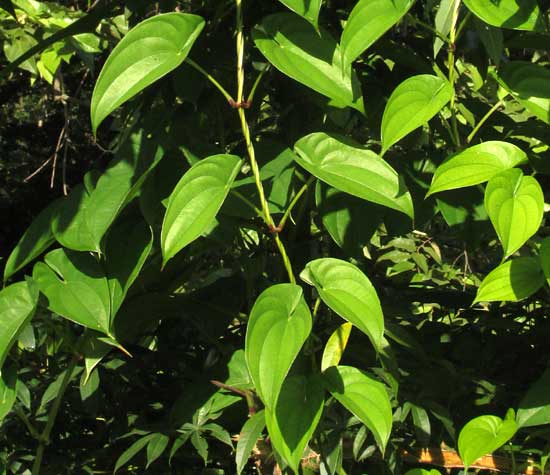
Last November we profiled a very similar vine, the Air Potato, Dioscorea bulbifera, of the Yam Family, the Dioscoreaceae. It produced "bubiles" on its stem, looking like angular potatoes. You can compare the current species with pictures on the Air Potato page at www.backyardnature.net/mexnat/air-pot.htm
Notice that on our present vine the sinuses between the leaves' backward-projecting "ears" are much narrower than on Air Potato leaves. However, on the Air Potato page you can see that secondary and tertiary veins on Air Potato leaves form irregular rectangles, which is a good field mark for members of the Yam Family. Our current vine's leaves display similar veiny rectangles, as shown below:
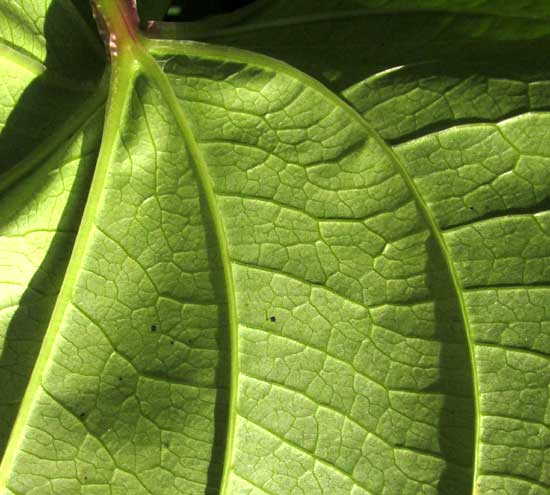
We have another member of the Yam Family here. Besides the narrow leaf sinuses, at this stage in the vine's development, the most conspicuous difference between it and the Air Potato vine is that our current species's stems are "winged," as you can clearly see below:
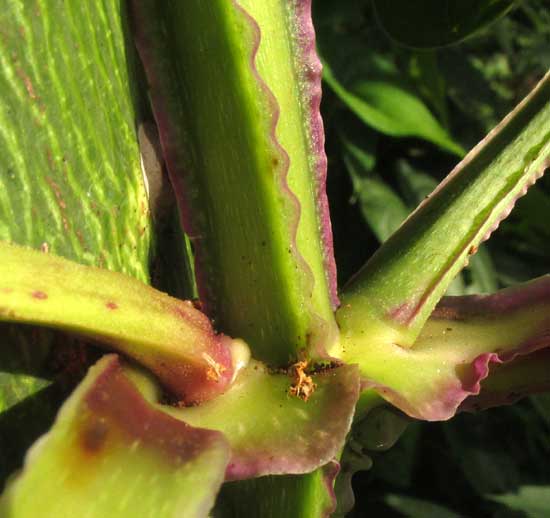
Air Potato vine stems don't have those curvy, purplish little outgrowths along the stems, known as wings. And those wings make our current vine easy to identify. Like the Air Potato, it's a member of the Yam Family genus Dioscorea and also originally from tropical Asia.
Our winged vine is DIOSCOREA ALATA, named in 1753 by Linnaeus himself. It's planted in the tropics worldwide for its large, edible, starchy tubers. Being so widely distributed in so many countries, it's known by many English names, including Winged Yam, White Yam, Purple Yam, Asiatic Yam, Greater Yam, Ten-months Yam Water Yam, etc.
The Maya call it Makal, which is curious because the vine couldn't look less like the other plant called Makal, traditionally grown at the edge of cornfields here. The traditional Makal looks like smaller versions of the huge, ornamental called Elephant Ears. When I mentioned this, the workers admitted that they do call both very different plants Makal. However, one of them knew that the traditional Elephant-Ear Makal is Kukut Makal, while our vine is Aak'il Makal.
I read that Winged Yam's stems can reach 30ft long (10), and that they can also bear bulbils, though not as frequently as Air Potato vines. I'm looking forward to digging up the tubers when the dry season returns and the vines die back.
from the August 22, 2010 Newsletter issued from Hacienda Chichen Resort beside Chichén Itzá Ruins, central Yucatán, MÉXICO
Planting Ñames
Finally Luis showed me the Ñame (NYAH-meh), sometimes called Winged, Water or White Yam, he was about to plant. You can see Luis in his Virgin of Guadalupe cap holding half a rooting Ñame tuber below:
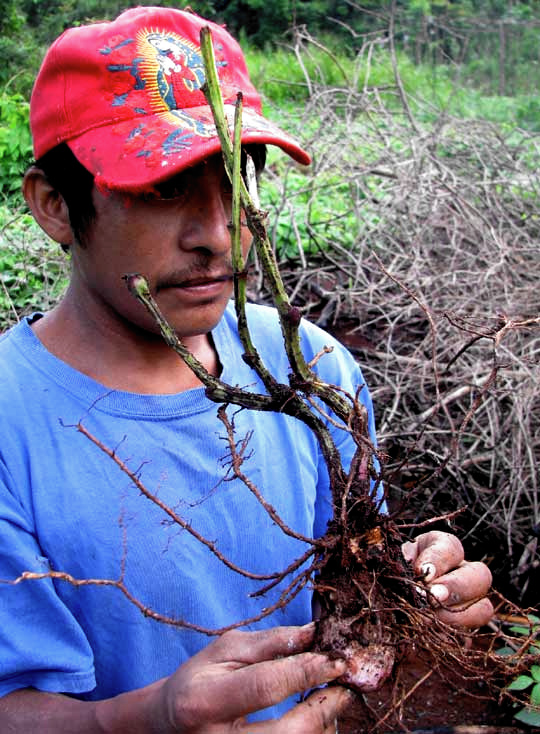
Ñame is DIOSCOREA ALATA, a member of the Yam Family, the Dioscoreaceae. In English sometimes it's referred to as White Yam or Water Yam. In eastern North America at the beginning of winter often you see slender, frost-bitten vines at woods edges bearing straw-colored, Chinese-lantern affairs. Those vines are usually called Wild Yams, and they're in the same genus as Ñame, Dioscorea. Wild Yam tubers are very hard and small compared to Ñame's. Ñame is thought to be a native of southern Asia. Its tubers can be enormous. When Luis spread his hands to show how wide he expects his yams to grow, they were about two feet apart (60 cm), so we'll just see if he exaggerates much!
from the December 17, 2017 Newsletter issued from Rancho Regenesis in the woods ±4kms west of Ek Balam Ruins; elevation ~40m (~130 ft), N20.876°, W88.170°; north-central Yucatán, MÉXICO
DIGGING WINGED YAM
In the above section, a Maya gardener tells us that Ñame, or Winged Yam, tubers can reach two feet (60cm) across. This week I dug up my one plant. Before starting to dig, I photographed the vine's stems where they entered the soil, along with some of the tuber-like "bulbiles" that formed on the vines' stems. The picture is shown below:
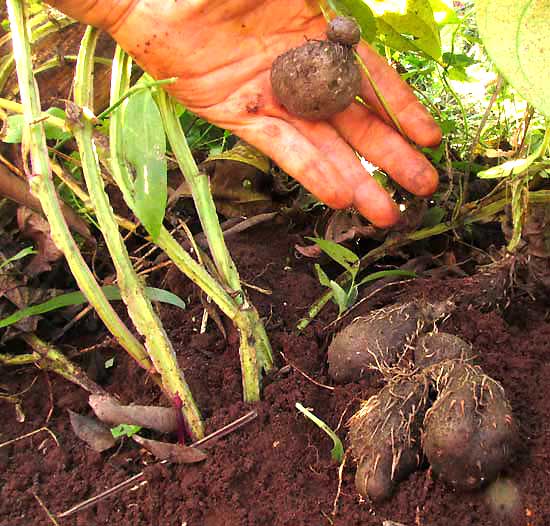
In the above picture, the bulbiles in my hand are still attached to the vine, while the lower ones have fallen onto the ground. Another bulbile-producing, vine member of the Yam Family, the Air Potato -- whose bulbiles have a different appearance -- shouldn't be confused with Winged Yam. Our Air Potato page is at www.backyardnature.net/mexnat/air-pot.htm
Now look at our Winged Yam's partially exposed tubers, with my machete included for scale:
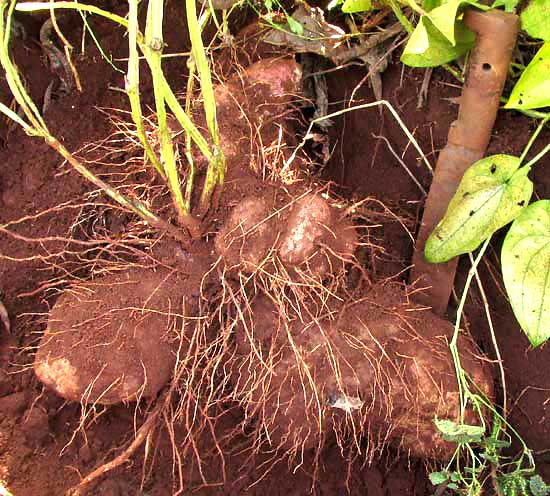
The entire tuber cluster removed from the ground appears below:
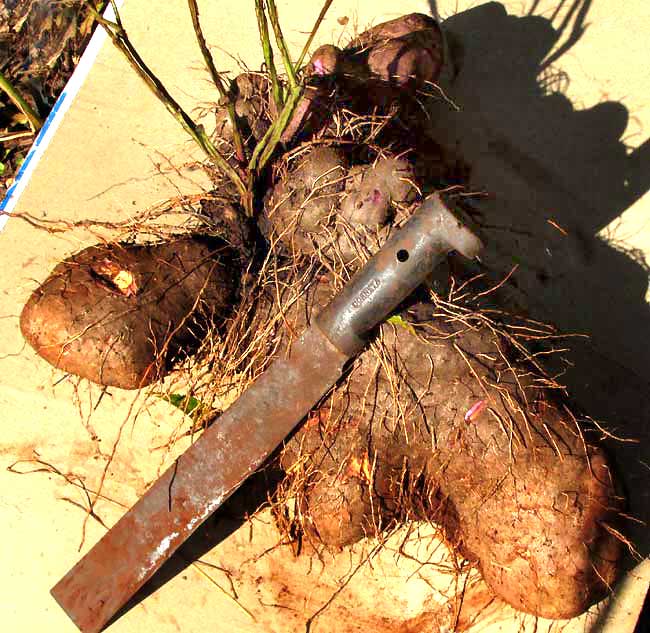
My machete with its broken blade is 16½ inches long (42cm), so the tuber is about 20 inches broad (51cm). This isn't as large as the gardener on our page says, but now I can believe that such big tubers are possible. When I planted my Winged Yam, I still hadn't realized how hard and impoverished our garden soil was, and I had neglected to pickax and beat the soil, and mix it with lots of manure, as I do all my plantings now. I'll bet that if I'd plant one in such a way now, I might end up with some two-foot-wide tubers, or larger.